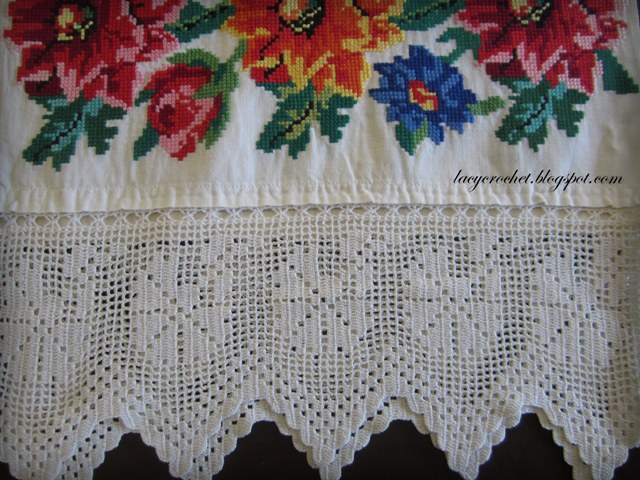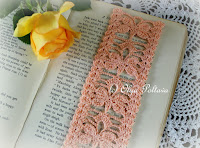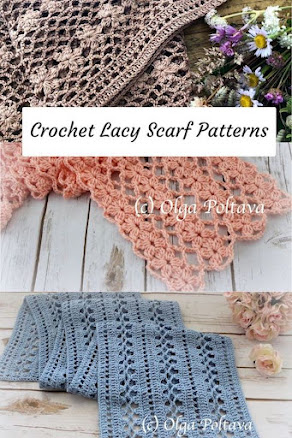And if you want to stiffen your doily a bit, just
spray on it some spray-on starch after you straightened your doily on the
towel.
I found the pattern for the doily pictured above here. Since this vintage pattern is no longer covered by the copyright and is in the public domain, I repost the pattern below.
Starting at center, ch 8. Join with sl st to form ring.
1st Rnd: Ch 6 (to count as tr and ch 2), 11 tr in ring with ch-2 between, ch 2, sl st in 4th st of ch-6.
2nd Rnd: Sl st in next ch, sl st in sp, ch 8, *tr in next sp, ch 4. Repeat from * around. Join last ch-4 with sl st in 4th st of starting chain.
3rd Rnd: Sl st in next 2 ch, sl st in sp, ch 10, * tr in next sp, ch 6. Repeat from * around. Join.
4th Rnd: Sl st in sp, ch 4, 5 tr in same sp, * ch 3, 6 tr in next sp. Repeat from * around. Join.
5th Rnd: Ch 9, * skip 4 tr, tr in next tr, 5 tr in sp, tr in next tr, ch 5. Repeat from * around, ending with 5 tr in last sp. Sl st in 4th st of starting chain.
6th Rnd: Ch 8, * tr in next 3 tr, in next tr make tr, ch 2 and tr; tr in next 3 tr, ch 4. Repeat from * around. Join.
7th Rnd: Ch 7, * tr in next 3 tr, 2 tr in next tr, ch 3, 2 tr in next tr, tr in next 3 tr, ch 3. Repeat from * around. Join.
8th Rnd: Ch 6, * tr in next 4 tr, (4 tr in next tr) twice; tr in next 4 tr, ch 2. Repeat from * around. Join.
9th Rnd: Sl st in next ch, sl st in sp, ch 7, * holding back the last loop of each tr on hook make tr in next 4 tr, thread over and draw through all loops on hook (4-tr cluster made), ch 3, tr in next 8 tr, ch 3, make a 4-tr cluster as before over next 4 tr, ch 3, tr in sp, ch 3. Repeat from * around. Join.
10th Rnd: Ch 8, tr in same place as sl st, ch 5, tr in next 8 tr, ch 5, 7 tr in next single tr, ch 5, tr in next 8 tr, ch 5, in next single tr make tr, ch 4 and tr. Repeat from * around. Join.
11th Rnd: Ch 4, 4 tr in same place as sl st, * ch 5, 5 tr in next tr, ch 5, make an 8-tr cluster over next 8 tr, ch 5, in next tr make tr, ch 1 and tr; (ch 1, tr in next tr) 5 times; ch 1, in next tr make tr, ch 1 and tr; ch 5, make an 8-tr cluster as before, ch 5, 5 tr in next tr. Repeat from * around. Join.
12th Rnd: Ch 4 (to count as tr), holding back the last loop of each tr on hook make tr in next 4 tr and complete a 5-tr cluster, * ch 3, 5 tr in center st of next ch-5, ch 3, make a 5-tr cluster over next 5 tr, ch 5, in tip of next cluster make tr, ch 3 and tr; ch 5, tr in next 9 tr with ch-2 between, ch 5, in tip of next cluster make tr, ch 3 and tr; ch 5, 5-tr cluster over next 5 tr. Repeat from * around. Join.
13th Rnd: Sl st in next 3 ch and in next tr, ch 4, tr in next 4 tr, * ch 5, skip next cluster, tr in next sp, (ch 3, tr in next sp) twice; (ch 3, 3-tr cluster in next sp) 8 times; (ch 3, tr in next sp) 3 times; ch 5, tr in next 5 tr. Repeat from * around. Join.
14th Rnd: Ch 4 and complete 5-tr cluster as before, * ch 3, in next sp make tr, ch 3 and tr, (ch 3, tr in next sp) 3 times; ch 10, skip 4 clusters, in next sp make tr, ch 4 and tr; ch 10, skip 4 clusters, tr in next sp, (ch 3, tr in next sp) 3 times; ch 3, tr in same sp where last tr was made, ch 3, 5-tr cluster over next 5 tr. Repeat from * around. Join last tr with dc in tip of 1st cluster made.
15th Rnd: Sl st in sp, ch 11, * tr in next sp, (ch 3, tr in next sp) 5 times; (ch 5, 7 tr in next tr) twice; ch 5, tr in next sp, (ch 3, tr in next sp) 5 times; ch 7. Repeat from * around. Join last ch-3 with sl st in 4th st of ch-11.
16th Rnd: Sl st in sp, ch 11, tr in same sp, * (ch 3, tr in next sp) 5 times; ch 7, make a 7-tr cluster over next 7 tr, ch 5, 7 tr in center st of next ch-5, ch 5, make a 7-tr cluster over next 7 tr, ch 7, skip next sp, (tr in next sp, ch 3) 5 times; in next sp make tr, ch 7 and tr. Repeat from * around. Join last tr with dc in 4th st of starting chain.
17th Rnd: Sl st in sp, ch 7, * make 7 tr in center st of next sp, (ch 3, tr in next sp) 5 times; ch 7, sc in tip of cluster, ch 7, tr in next 7 tr, ch 7, sc in tip of next cluster; ch 7, skip 1 sp, tr in next sp, (ch 3, tr in next sp) 4 times; ch 3. Repeat from * around. Join with dc as before.
18th Rnd: Sl st in sp, ch 9, * tr in next 7 tr with ch-1 between, ch 5, skip 1 sp, tr in next sp, (ch 3, tr in next sp) 3 times; ch 7, sc in next sc, ch 11, make a 7-tr cluster over next 7 tr, ch 11, sc in next sc, ch 7, skip next sp, tr in next sp, (ch 3, tr in next sp) 3 times; ch 5. Repeat from * around. Join with dc as before.
19th Rnd: Sl st in sp, ch 11, * in next tr make tr, ch 2 and tr, (ch 2, tr in next tr) 5 times; ch 2, in next tr make tr, ch 2 and tr, ch 7, skip 1 sp, tr in next sp, (ch 3, tr in next sp) twice; ch 9, sc in next sc, 15 sc in each of next 2 ch-11 loops, sc in next sc, ch-9, skip 1 sp, tr in next sp, (ch 3, tr in next sp) twice; ch 7. Repeat from * around. Join with dc as before.
20th Rnd: Sl st in next sp, ch 11, * (make a 3-tr cluster in next sp, ch 3) 7 times; 3-tr cluster in next sp, ch 7, tr in each of next 2 ch-3 sps, ch 11, dc in next sc, (ch 2, skip 2 sc, dc in next sc) 5 times; ch 5, dc in next sc, (ch 2, skip 2 sc, dc in next sc) 5 times; ch 11, tr in each of next 2 ch-3 sps, ch 7. Repeat from * around. Join last tr with sl st to 4th st of starting chain.
21st Rnd: Ch 1, sc in same place as sl st, * ch 7, tr in next sp, (ch 5, tr in next sp) 8 times; ch 7, skip 1 tr, sc in next tr, ch 11, (dc in next ch-2 sp, ch 2) 5 times; in next sp make dc, ch 5 and dc, (ch 2, dc in next sp) 5 times; ch 11, skip 1 tr, sc in next tr. Repeat from * around, ending with sl st in 1st sc made.
22nd Rnd: Ch 1, sc in same place as sl st, * ch 7, skip next sp, (make a 5-tr cluster in next sp, ch 7) 8 times; sc in next sc, ch 13, (dc in next ch-2 sp, ch 2) 5 times; in next sp make dc, ch 5 and dc, (ch 2, dc in next sp) 5 times; ch 13, sc in next sc. Repeat from * around. Join and fasten off.




















































































